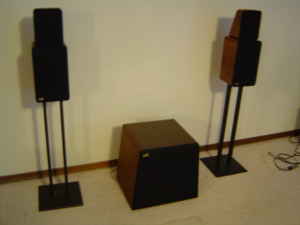Sub sats
by Paul McGowan
I often get asked why we need reasonably sized speaker boxes. After all, if we're willing to include a subwoofer in our mix, why couldn't the midrange tweeter boxes be tiny?
There was a time when this thinking produced an entirely new category of system called the Sub Sat.
I was one of the first to embrace a 3-piece Sub Sat system. Mine was from M and K, a long-ago company founded by LA audio dealer Jonas Miller, and engineer Ken Kreisel. (*I believe the company, M and K Sound still exists but it's more name than anything else).
This was back in the day when subwoofers were first appearing on the scene. At that time, people thought a good sub could replace a proper speaker enclosure, which is how this 3-piece sub sat system came to be.
The idea of the sub sat was simple: two small satellite speakers with a tweeter and tiny woofer/midrange, and a single subwoofer would finish the system. It was a grand idea, but it didn't live up to its hype.
If memory serves, I believe I owned that system for a total of about two weeks before I ofted it to a friend who wasn't as crazy about sound as I was.
As you might have guessed, the problem is that subwoofers only work when they don't have to play very high frequencies. Once a subwoofer is asked to produce audio above 30 to 40Hz, you start to hear the sub as a separate entity.
Thankfully, the Sub Sat genre died out rather quickly, but it was a nifty idea that I bought into just because it was novel, cool, and filled with potential.
Today we know that in order to produce seamless sound, the satellite part of any system has to have a big enough enclosure to support a decent bottom end.
In other words, your left and right main speakers need to be reasonably full range in order for a subwoofer to do its job.
- Choosing a selection results in a full page refresh.
- Opens in a new window.








